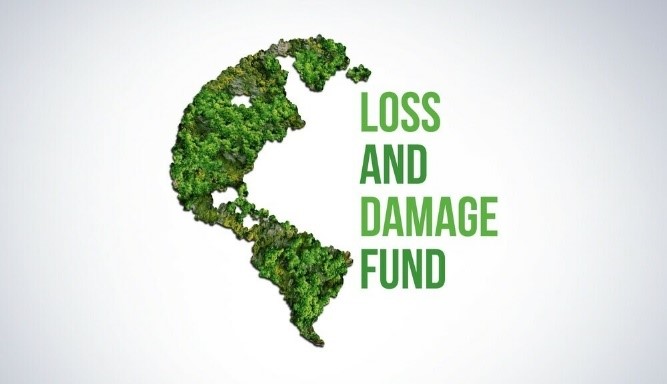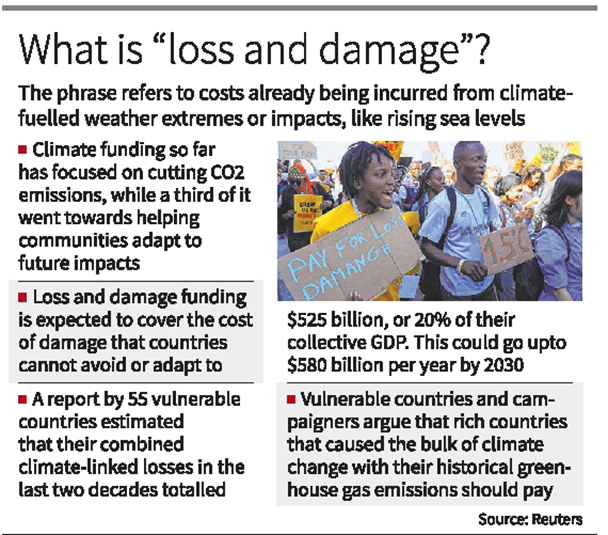Description

Disclaimer: Copyright infringement not intended.
Context
- As the climate crisis intensifies, two terms are in sharp focus: adaptation and ‘loss and damage’ (L&D).

The term “loss and damage" dominated COP27. What does it mean exactly?
- Put simply, “loss and damage” refers to costs the rich and developed countries, who are majorly responsible for industrial emissions that pollute the environment, should pay to poorer nations that have made negligible contributions to pollution but are more vulnerable to extreme climate events.
- While the vulnerable countries have been asking for climate damage finance for decades now, the rich countries have resisted it. Also, it is difficult to define and assess damage caused purely due to climate change.
- Loss and damage refer to the negative consequences that arise from the unavoidable risks of climate change, like rising sea levels, prolonged heatwaves, desertification, the acidification of the sea and extreme events, such as bushfires, species extinction and crop failures. As the climate crisis unfolds, these events will happen more and more frequently, and the consequences will become more severe.
READ ABOUT COP 27:
https://www.iasgyan.in/daily-current-affairs/cop27-hits-and-misses
https://iasgyan.in/daily-current-affairs/run-up-to-cop27
.jpg)
Historically, G20 countries have emitted majority of the greenhouse gases driving the climate crisis. How is this impacting developing countries?
- The African continent for example, contributes the least to climate change yet is the most vulnerable to its impacts.
- African countries that contribute so little will have to spend up to five times more on adapting to the climate crisis than on healthcare.
- G20 countries, meanwhile, represent around 75 per cent of global greenhouse emissions.
- Meanwhile, Pakistan has seen US$30 billion in damages from severe flooding but emits less than 1 per cent of global emissions.
History of the demand
- At its heart, the demand for compensation for loss and damage from climate disasters is an extension of the universally acknowledged “Polluter Pays” principle.
- This principle makes the polluter liable for paying not just for the cost of remedial action, but also for compensating the victims of environmental damage caused by their actions.
- In the climate change framework, the burden of responsibility falls on those rich countries that have contributed most of the greenhouse gas emissions since 1850, generally considered to be the beginning of the industrial age.
- The United States and the European Union, including the UK, account for over 50 percent of all emissions during this time.
- If Russia, Canada, Japan, and Australia are included, the combined contribution goes past 65 per cent, or almost two-thirds of all emissions.
- Historical responsibility is important because carbon dioxide remains in the atmosphere for hundreds of years, and it is the cumulative accumulation of this carbon dioxide that causes global warming.
- A country like India, currently the third largest emitter, accounts for only 3 per cent of historical emissions.
- China, which is the world’s biggest emitter for over 15 years now, has contributed about 11 per cent to total emissions since 1850.
How can funds be raised or mobilized to compensate for loss and damage?
- United Nations Environment Programme (UNEP) research shows that finance for adaptation falls short.
- The 2022 Adaptation Gap Report indicates that international adaptation finance flows to developing countries are five to ten times below estimated needs, and will need over US$300 billion per year by 2030.
- Loss and damage finance needs are closely connected to our ability to mitigate and adapt to climate change.
- Some traditional financing instruments could be used to deal with loss and damage.
- Social protection, contingency finance, catastrophe risk insurance and catastrophe bonds can provide a certain buffer and rapid pay-outs after disasters.
- However, a broadened donor base and innovative finance tools would be needed to respond to the magnitude of loss and damage.
What are some examples of those innovative tools?
- The UN Secretary-General António Guterres, for example, has called for the use of windfall taxes on fossil fuel companies and diverting the money to people struggling with rising food and energy prices and to countries suffering loss and damage caused by the climate crisis.
- Others have called for debt for loss and damage swaps, international taxes and a dedicated finance facility for loss and damage under the UN Framework Convention on Climate Change.
- At COP 26 and 27 philanthropies and country governments pledged funds for loss and damage. These efforts could be scaled up considering the mounting challenges of the most vulnerable communities.
What is UNEP doing to combat loss and damage?
- UNEP is at the forefront of producing up-to-date, accurate science and knowledge on the impact of climate change. UNEP supports countries to collect and process environmental data. UNEP's landmark studies such as the Emissions Gap Report and the Adaption Gap Report, provide critical information to policymakers around the world.
- Community and ecosystem-based adaptation is critical to building resilience to the impacts of the climate crisis.
- UNEP is currently supporting over 50 ecosystem-based adaptation projects. These projects aim to restore around 113,000 hectares and benefit around 2.5 million people worldwide.
- UNEP is also supporting demand-driven technical assistance to climate information such as early warning systems and capacity building in countries such as Timor-Leste, Azerbaijan, El Salvador, Ghana, Maldives, Sudan and the Pacific island developing states.
.jpg)
Will the Loss and Damage Fund be effective?
- It is important that a Loss and Damage Fund tackles the gaps that current climate finance institutions such as the Green Climate Fund do not fill.
- Combined adaptation and mitigation finance flows in 2020 fell at least US$17 billion short of the US$100 billion pledged to developing countries.
- The Transitional Committee will provide recommendations for the set up and operations of the fund.
- The Committee will also recommend which countries should receive funding and who should be paying into the fund. All of that needs to be decided upon.
- But for the fund to be effective, the root cause of climate change must be tackled – and that involves reducing emissions.
- Unless emissions are drastically reduced, more and more countries will face the devastating effects of climate change.
- The world urgently needs to find more resources for mitigation, adaptation and loss and damage so that climate change will not erode humanity's chances to deliver on the Sustainable Development Goals.
|
PRACTICE QUESTION
Q. Historically, G20 countries have emitted majority of the greenhouse gases driving the climate crisis. How is this impacting developing countries? Discuss this in the context of Loss and Damage Fund.
|













